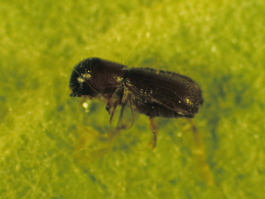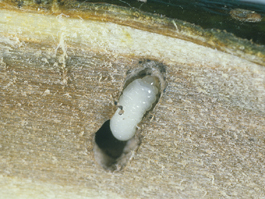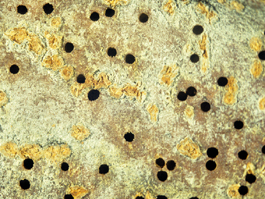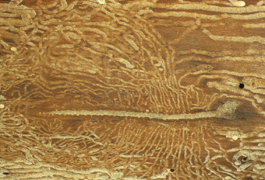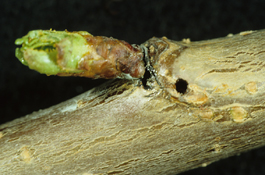by Mike Doerr and Phil VanBuskirk, originally published 1993
(Coleoptera: Curculionidae, Scolytinae)
Shothole borer (or fruittree bark beetle)
Scolytus rugulosus Müller
European shothole borer (or ambrosia beetle)
Xyleborus dispar Fabricius
Lesser shothole borer (or ambrosia beetle)
Xyleborus saxeseni Ratzeburg
Shothole borers are small beetles that were introduced from Europe and have spread over most of the United States and southern Canada. They were first reported in the Northwest in the early 1900s. They are destructive pests of forest trees but also attack fruit, shade and ornamental trees and shrubs.
The shothole borer (Scolytus rugulosus) is a bark beetle that lives between the bark and the surface of the wood, scoring the sapwood. It feeds on the tree’s succulent phloem tissue. Ambrosia beetles bore into the wood of trees, forming galleries in which both adults and larvae live. They feed on an ambrosia fungus, which they cultivate.
All shothole borers are attracted to injured or stressed trees. Because chemical controls have not proven very successful, the best management approach is to keep trees healthy.
Hosts
Apple, pear, cherry and plum are among the fruit trees attacked by shothole borers.
Life stages
Shothole borer
Egg
The egg is oval or round and a shiny, pearly white color.
Larva
The larva is white, legless and about 1/6 inch (4 mm) long. The body is slightly enlarged just behind the head.
Pupa
The pupa is white with sparse hairs and numerous large, thick tubercles. It is about 1/6 inch (4 mm) long.
Adult
The adult beetle is about 1/12 inch (2 mm) long. It is brownish black with brown legs and antennae and has a short, stubby snout with chewing mouthparts. The thorax is shiny and elongated. The wing covers are dull, and the interstices (the parts between the body sections) are wrinkled.
Ambrosia beetles
Egg
The egg is oval or round and shiny, pearly white.
Larva
The larva is pinkish white, cylindrical and legless. It passes through five instars and when mature is about 1/6 inch (4 mm) long.
Pupa
The pupa is white.
Adult
The adult female Xyleborus dispar is about 1/8 inch (3 mm) long and winged. It has a dark brown or black body covered with yellowish hairs and pale brown legs and antennae. The adult male is wingless and shorter, with a relatively small thorax and short abdomen. The adult Xyleborus saxeseni is only about 1/10 inch long. It can be pale brown to black.
Life history
Shothole borer
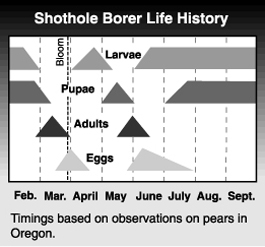 Larvae overwinter in burrows beneath the bark, where they pupate. Adults emerge in the spring or early summer and often feed at the base of leaves or small twigs before they tunnel into the tree through the bark. They then excavate narrow galleries running parallel to the wood grain. Each female deposits about 50 eggs in niches along the walls of the gallery. As the eggs hatch, the larvae excavate slender mines or burrows, usually at right angles to the maternal gallery, occasionally crisscrossing over one another between the bark and the sapwood.
Larvae overwinter in burrows beneath the bark, where they pupate. Adults emerge in the spring or early summer and often feed at the base of leaves or small twigs before they tunnel into the tree through the bark. They then excavate narrow galleries running parallel to the wood grain. Each female deposits about 50 eggs in niches along the walls of the gallery. As the eggs hatch, the larvae excavate slender mines or burrows, usually at right angles to the maternal gallery, occasionally crisscrossing over one another between the bark and the sapwood.
The larval burrows are filled with excrement and get wider as the larvae grow. When fully grown, about 6 to 8 weeks later, the larvae construct pupal cells at the ends of the mines. When they emerge as adults, they build exit burrows from the pupal cells to the outside. The numerous exit and entrance holes give the shothole effect. There are usually two generations a year in the northern states. Larvae of the second generation complete development during late winter and early spring as temperatures rise.
Ambrosia beetles
Ambrosia beetles overwinter as adults. In spring, when daily temperatures exceed 65ºF (18ºC), females become active and search for a suitable host. They are attracted to weak trees. Once they find a suitable tree, they bore into the bark, burrowing down to the sapwood or heartwood before excavating shorter tunnels to either side. Each female deposits between 40 and 50 eggs at the entrance of the shorter galleries, where the larvae are reared.
As eggs are laid over a period of several weeks, both young and old larvae live together in the same gallery. The female tends her young as they develop through May and June, carefully cultivating ambrosia fungus in the galleries for them to eat. The females have special organs for storing and carrying the fungal spores. The ambrosia fungus develops on a mixture of wood fibers and excrement and spreads to the various galleries, staining them dark brown or black. Unless consumed regularly, the fungus may close off the galleries, killing the larvae inside.
Female beetles usually remove any excrement pellets or debris produced by the larvae. Galleries of ambrosia beetles can be distinguished from those of other wood borers by the lack of wood dust and other refuse as well as their uniform size. Young adults, tightly packed one behind the other, may be found in the galleries starting in July and August where they remain in a state of diapause until the following spring. When temperatures warm in the spring, the adults mate and females leave galleries in search of a new host.
Damage
Shothole borer
The mining of the shothole borer can interfere with the movement of fluids through the cambium layer between the wood and the bark. Infested trees are usually weak and will be further weakened by the damage. Eventually, the tree will be girdled and killed. Young, healthy trees may also be attacked if they are close to a large source of beetles, such as a pile of prunings. A typical scenario is where an old orchard is removed in the fall, the cut wood is stacked near the edge, and new trees are planted in the spring.
Ambrosia beetles
Branches and stems of infested apple and pear trees will wilt and die. The damage is often mistaken for fire blight. Usually the beetle attacks weak or damaged trees, but young, vigorous trees can also be infested. Trunks and large branches may become completely riddled with galleries.
Monitoring
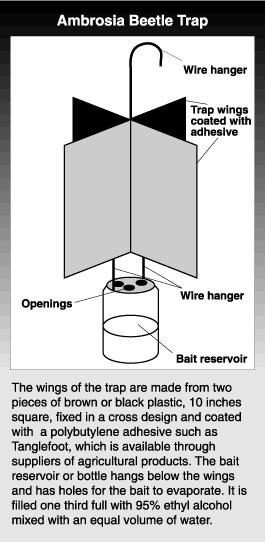 Examine trunks and branches in late May or early June. On infested trunks and limbs, there often will be holes about 1/12 inch (2 mm) in diameter, oozing sap and sawdust. Holes without fresh sawdust are most likely from previous years and no longer contain beetles. On stone fruits, the entrance and exit holes are usually covered and sealed with a gummy ooze or dried droplets of gum, which hang from the twigs and branches like teardrops. Pay special attention to areas that have a history of attacks, that are near hedges, brush piles or wooded areas, or that have had freeze damage. Bear in mind that the beetles attack primarily unhealthy trees.
Examine trunks and branches in late May or early June. On infested trunks and limbs, there often will be holes about 1/12 inch (2 mm) in diameter, oozing sap and sawdust. Holes without fresh sawdust are most likely from previous years and no longer contain beetles. On stone fruits, the entrance and exit holes are usually covered and sealed with a gummy ooze or dried droplets of gum, which hang from the twigs and branches like teardrops. Pay special attention to areas that have a history of attacks, that are near hedges, brush piles or wooded areas, or that have had freeze damage. Bear in mind that the beetles attack primarily unhealthy trees.
Ambrosia beetle flights can be monitored with traps such as the one shown. Small pails filled with the alcohol bait can also serve as traps. Beetles attracted to the trap drown in the liquid and can easily be counted.
In areas previously attacked, begin trapping in late March or early April using 2 to 4 traps per acre. Place traps in the tree near the trunk, about 4 to 5 feet (1.5 meters) from the ground. During warm weather, flights last 3 to 4 weeks. In cold or variable weather, they can last up to 6 weeks. If fewer than 20 beetles are caught per trap per season, little or no damage is likely. If catches exceed 20 beetles per trap per season there is potential for serious damage and control measures should be taken.
Biological control
Shothole borers are preyed upon by birds (chiefly woodpeckers), checkered beetles, hymenopterous parasites and parasitic bacteria and fungi.
Management
Healthy, vigorous trees that are well cared for are less subject to attack. Give sickly trees adequate water and fertilizer. In areas prone to sunburn or winter damage, paint trunks with a solution of equal parts of latex paint and water to prevent damage to the trees. Sanitation is the key to successful shothole borer control. In winter, remove and burn infested and diseased trees or branches of both orchard trees and other nearby hosts. This will prevent beetle populations building up to the point where they might attack healthy wood.
Baited traps like those used for monitoring can be used to control ambrosia beetles. Space traps evenly throughout areas previously attacked, using at least 8 per acre. The success of the trap depends primarily on how attractive the alcohol bait is to the beetle. Several chemicals are registered for use against shothole borers, most of which are directed at adult beetles. Chemical controls can be applied whenever adults are present, from late March to September. However, they are of limited value, and the best control method is to keep trees healthy.
